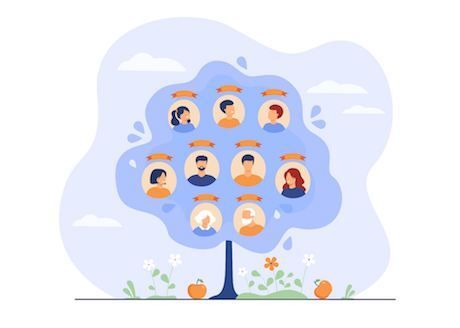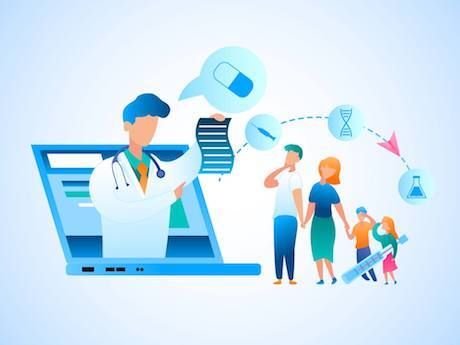Genetic Genealogy
By Dr. Brandon Colby MD, an expert in genetic testing, DNA analysis, and personalized medicine.
Have you ever wondered about who your ancestors were, and where exactly they came from? Pondering about our biological roots is perfectly normal, and many of us have surely thought about it more than once throughout our lives.
Some families are lucky enough to have plenty of recorded information about their ancestors. In some cases — such as royal and noble families around the world — they have extensive archives that detail the lives of each and every family member, making it easy to determine who is related to who, and where everyone comes from. Imagine what the Queen of England’s family tree looks like!
Unfortunately, most of us don’t have access to such detailed records about our ancestors. For most of recorded history, it was impossible to simply take a genetic test and discover your exact genealogy and ethnicity, and going through archives and historical records was a time-consuming process that wasn’t available to everyone.
Thanks to the development of modern genomics, you can now take a swab sample from the comfort of your own home, and simply wait a few weeks to receive your test results and discover exactly who your ancestors were.
Let’s talk more about genetic genealogy, how it works, and what you can learn from it.
What Is Genetic Genealogy

Genetic genealogy is a field of genealogy and family history research1 that combines genealogical DNA tests and traditional genealogy methods to discover how individuals are related.
When genetic testing first became commercially available, it was an incredibly expensive endeavor that was simply out of reach for most people. Thankfully, genetic testing has become far more affordable in recent years — in fact, you can have your entire genome sequenced for just a few hundred dollars nowadays. As a result, genealogical research has evolved to take genetic testing results in mind, which has allowed genealogy to become much more specialized and accurate.
Practically anyone could discover a treasure trove of useful and interesting genealogic information thanks to DNA testing; however, certain people could find it especially interesting and helpful. Those who have lost contact with their biological families, such as adoptees, can use these tests to discover their birth parentage and answer questions regarding their ethnicity and biological origins. DNA testing can also be used to establish paternity in doubtful cases.
Genetic findings are also immensely helpful in the field of medical research. Molecular genealogy, in particular, seeks to understand the patterns of inheritance that have shaped evolution for thousands of years, modifying the ways different organisms function according to changes in their DNA.2
Genetic genealogy can also be used in criminology and law enforcement — it has even helped solve cold cases in this field. DNA samples from crime scenes can be uploaded to genetic databases to identify relatives of unknown suspects, which narrows down the search.3 After this is done, traditional genealogy methods can be used to build family trees from the matches until the most likely suspect is identified. In some cases, all it takes is for one distant relative of the suspect to upload their genetic results to genealogy sites for a case to be solved after decades of silence.
There are many stories of success using genetic genealogy. Dr. Ann Turner, for example, is a genealogy advocate and educator who has used genetic testing to explore both her ancestry and medical genetics.4 She has published research that has broken through “brick walls” in her family tree, and her continuous genealogy research has even allowed scientists to discover genes involved in hearing loss, which is a condition that had been present in her family for hundreds of years without an identified cause.
Her personal research spans back over several centuries, and she has enlisted many family members who have provided DNA samples that have allowed them to trace back their ancestry to common ancestors who lived centuries ago. Other groundbreaking genetic genealogists include CeCe Moore and Debbie Parker Wayne, among others.
How Does Genetic Genealogy Work

When a sample of your DNA is analyzed for genealogy purposes, the aim of the test is to find other samples that share genetic similarities with you. These similarities can be used to ascertain likely familial relationships, along with establishing the geographic location from where this DNA originated.
Genetic ancestry testing aims to determine your haplotype, which are alleles that we inherit from one of our parents. Together, similar haplotypes from haplogroups, which share common ancestors that can be determined thanks to the presence of specific variants in the DNA.
What is a centimorgan?
A centimorgan (cM) or map unit (m.u.) is the unit used to measure degrees of genetic linkage. A centimorgan chart or relationship calculator can be used to determine connections to relatives through shared ancestors.
It has been estimated that approximately 30 million people have had the DNA tested for genealogical purposes. As these tests become more widely available and more people get tested, the genetic databases used to perform family matching will gain more depth and we will surely be able to discover more inclusive family relationships.
About Genetic Genealogy Testing
Overall, all types of genealogy DNA tests look for similarities between your DNA and the DNA that is contained in current genetic databases to establish who you may be related to. However, the function of these tests varies depending on the types of DNA that they examine.
You may be thinking, “I thought each of us only had one DNA sequence?”
Well, yes! Different types of genetic testing can reveal different sections of your family tree. There are different types of DNA genealogy testing, which include:
Y chromosome testing, also known as Y-DNA testing, explores your ancestry through the male lineage. It can look for single nucleotide polymorphisms (SNPs) testing or short tandem repeats (STR), which are possible variants in your DNA that can be matched to other people’s genetic data. Y-DNA testing can only be performed in men since women don’t have a Y chromosome; however, women who want to take this type of test can enlist male relatives to help them.
Mitochondrial DNA testing analyzes mitochondrial DNA or mtDNA, which is passed down from mother to child. This type of DNA testing allows people to discover their ancestry through their direct female ancestral line.
All human beings have mitochondria, regardless of their gender — meaning that anyone can use mtDNA testing. Mutations in mtDNA are relatively rare, and so, a perfect mtDNA match could share your ancestry anywhere between 1 to 50 generations ago. All human beings are descended from an unknown woman who we now refer to as “mitochondrial Eve”, who probably lived in Africa around 150,000 years ago.
Interestingly, Y-DNA and mtDNA have even been used to analyze the DNA of remains found in archaeological sites and ancient migration paths.
Autosomal DNA (atDNA) testing, on the other hand, analyzes your entire DNA excluding Y-DNA and mtDNA. This type of testing can result in a much more significant amount of ancestry matches. This type of test is very useful to determine your biogeographic ancestry since the SNPs found in your results are then compared to the distribution of SNPs in DNA samples hailing from different areas.
How Accurate Are DNA Tests for Genealogy

The answer is… it depends. The testing processes themselves are highly accurate — however, the thoroughness of your individual results can depend on other factors. Like we previously mentioned, genealogy genetic testing works by comparing DNA samples to pre-existing genetic databases. Since different testing companies can have different databases or use different matching algorithms, your ethnicity estimates could vary depending on the provider you use.
It’s also important to note that the reliability of your results will largely depend on the depth of the reference database that the company uses. For individuals who belong to a small ethnic group with a smaller range of genetic variants in the DNA, it can be difficult to determine an exact family tree.
Certain ethnicities are also easier to determine since they’re more highly represented in reference databases. For example, most databases have many more samples containing Caucasian DNA components than Native American DNA — as a result, samples containing Native American DNA will be harder to compare against databases.
Genetic Genealogy Testing Companies
There are many companies that currently offer genetic genealogy testing or reference databases, such as Sequencing.com, GEDmatch, AncestryDNA, 23andMe, FamilyTreeDNA, HomeDNA, YBrowse,, among others. Let’s discuss some of the main companies that provide DNA testing used for ancestry research:
AncestryDNA
AncestryDNA is a DNA testing service provided by the popular website Ancestry.com. This service uses microarray-based autosomal DNA testing, which only analyzes around .02 percent of all the genetic markers that could possibly be tested in order to provide an “ethnicity estimate” and infer family relationships.
MyHeritage
MyHeritage provides autosomal genetic data — however, it misses vital data contained in mtDNA and Y-DNA. It also provides a database that can be browsed by its users. The type of testing used by MyHeritage only analyzes 0.1 percent of your genome, and it only looks for SNPs without sequencing base pairs.
23andMe
In 2007, the company 23andMe became the first company to provide direct-to-consumer DNA testing that could be performed using a saliva sample. 23andMe was also the first provider to use autosomal DNA testing, which has since become the standard type of ancestry genetic testing used by many companies.
23andMe offers a feature called ancestry painting5, which is designed to determine the most likely geographic pre-colonial origin of each of your 22 bi-parentally inherited chromosomes. The results can be a combination of an African Ancestry Painting, European Ancestry Painting, African American Ancestry Painting, Native American Ancestry Painting, and Asian Ancestry Painting.
Sequencing.com
In addition to providing data that can be used for genealogical purposes, Sequencing.com also offers whole genome sequencing, which can be used for numerous health purposes. Unlike other types of DNA testing, whole genome sequencing analyzes the portions of your DNA that are used to determine your ancestry, but it also sequences your entire DNA to find variants associated with health risks, genetic disorders, general wellness, and much more.
Along with offering low-cost and comprehensive testing, Sequencing.com also offers genetic reports which are compatible across many genetic testing platforms — but we’ll talk more about that in just a bit.
Online Genealogy Resources
Thanks to the popularization of commercial genetic testing, numerous online resources have become available for people who want to learn more about what genealogy is. The advent of social media has also made it easier to find long lost relatives and get in touch with them. As a result, numerous social media groups have popped up across various platforms, creating extensive communities who are looking to find their relatives.6
Blogs have also become useful genealogy tools for those who want to discover more about this fascinating topic. The Genetic Genealogist,7 is a long-running blog run by Blaine Bettinger, Ph.D., J.D., and it features educational posts on different topics that examine the convergence of genetic genealogy and traditional genealogy methods.
The International Society of Genetic Genealogy (ISOGG)8 is a group that seeks to promote DNA testing for genealogy purposes. Their website even features its own wiki section, which contains numerous pages full of relevant information that can help anyone dive into the world of genetic genealogy. The ISOGG also aims to maintain a Y-SNP tree that is constantly updated with new findings.
The National Genealogical Society also provides extensive online learning center9 and information regarding many different genealogy societies and organizations.
Another useful online resource is WikiTree or The Free Family Tree, a community where users can share their own family trees and research genealogy using DNA testing and traditional genealogy methods.10
Dr. Ann Turner — who we mentioned earlier in the article — was inspired by her own genealogic research to establish her own mailing list, called GENEALOGY-DNA11; she also co-authored a book called “Trace Your Roots with DNA: Using Genetic Tests to Explore Your Family Tree.” Other mailing lists also keep their subscribers updated on new discoveries in the field.
Genealogy Reports
Genetic genealogy reports compare your raw DNA data to various reference databases to determine your ancestral composition and disclose it back to you. These results can be more or less extensive depending on the type of testing that was used — mtDNA, Y-DNA, atDNA, or a combination of tests. In fact, reports like the ones here at Sequencing.com could even reveal whether you’re related to a famous historical figure.
Different providers may choose to deliver reports in different forms. For example, Other companies offer many different types of personalized ancestry reports.
DNA Test Compatibility
Many genetic testing providers allow users to download DNA data from their results and use it on other sites. This will give you the option to upload your results to other platforms to perform a deeper genetic analysis.
Depending on the provider you use, your genetic data could be compatible across many different genealogy sites. At Sequencing, for example, we provide the Ultimate Compatibility File with your results. This txt. file contains raw DNA data and is designed to work with numerous third-party sites for you to perform your own DNA data upload, in addition to accessing our own ancestry apps.
If you want to learn more about genetic genealogy and other uses of DNA testing, head over to our Education Center now to find lots of useful information.
About The Author
Dr. Brandon Colby MD is a US physician specializing in the personalized prevention of disease through the use of genomic technologies. He’s an expert in genetic testing, genetic analysis, and precision medicine. Dr. Colby is also the Founder of Sequencing.com and the author of Outsmart Your Genes.
Dr. Colby holds an MD from the Mount Sinai School of Medicine, an MBA from Stanford University’s Graduate School of Business, and a degree in Genetics with Honors from the University of Michigan. He is an Affiliate Specialist of the American College of Medical Genetics and Genomics (ACMG), an Associate of the American College of Preventive Medicine (ACPM), and a member of the National Society of Genetic Counselors (NSGC).
- 1
- Genetic genealogy. International Society of Genetic Genealogy Wiki. Retrieved January 16, 2021. ↩
- 2
- Schwabe C. Molecular Geneology. In: Madame Curie Bioscience Database [Internet]. Austin (TX): Landes Bioscience; 2000-2013.↩
- 3
- Greytak, E. M., Moore, C., & Armentrout, S. L. (2019). Genetic genealogy for cold case and active investigations. Forensic Science International: 299(103–13).↩
- 4
- Bettinger, B. (2008, June 25). TGG Interview Series VI – Ann Turner. The Genetic Genealogist. Retrieved January 14, 2021. ↩
- 6
- Genetic genealogy mailing lists and Facebook groups. International Society of Genetic Genealogy Wiki. Retrieved January 17, 2021.↩
- 7
- The Genetic Genealogist. Retrieved January 15, 2021.↩
- 8
- Wiki Welcome Page. International Society of Genetic Genealogy Wiki. Retrieved January 15, 2021.↩
- 9
- National Genealogical Society. Retrieved January 14, 2021.↩
- 10
- WikiTree: The Free Family Tree. Retrieved January 14, 2021.↩